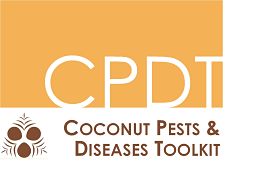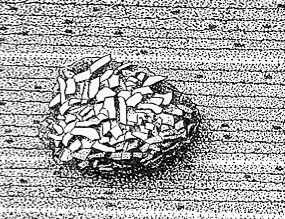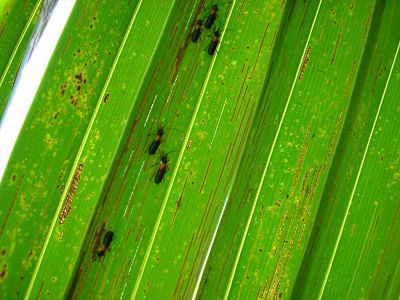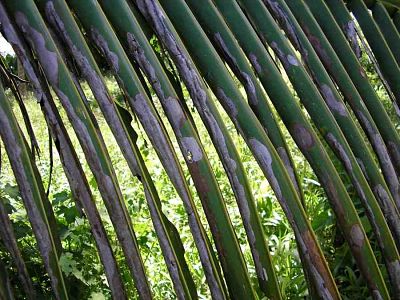Coconut leaf miner
Coconut leaf miner beetles are a serious pest insect of coconut. There is a high risk of outbreaks through incursions into new environments.
Common nameCoconut leaf miner |
Scientific namemany Promecotheca species |
on this page: Life-cycle and identification : Symptoms : Impacts : Distribution : Prevention : Controlling coconut leaf miner : Information sources and further reading
Life-cycle and identification
Coconut leaf miners are beetles. Beetles undergo complete metamorphosis. This means each stage of their life cycle looks completely different.
The four stages of the beetle life-cycle are egg, larva, pupa and adult. Often beetle eggs are difficult to find and beetle larvae are difficult to identify. Identification of adults is much easier.
Eggs : Larvae : Pupae : Adults
EggsEggs can be found in groups of 2-3 or singularly on the underside of recently opened fronds. They are about 1.5 mm long and covered with digested leaf fragments cemented together in a straw-coloured dome. For an explanation of specific life-cycles and identification for each species, look at Insects on Palms, pages 85-96. LarvaeLarvae are a long, flat caterpillar (about 1 cm by 2 mm) that live entirely within the leaf mine. They are a creamy-yellow colour with brown heads. Eggs hatch after 2-3 weeks (depending on the temperature - higher temperatures decrease timing) and the larvae emerge. |
Drawing of eggs covered in dome-shaped cemented and digested leaf fragments (© Caroline S. Chaboo, American Museum of Natural History) |
The larvae start to feed on the lower part of the frond, close to the midrib, making leaf mines (feeding channels) between the leaf surfaces. Here they undergo 2-3 growth stages (instars).
Mines can be 1 mm to 5 mm wide according to the larva's growth stages and the possible presence of more than one larva per mine.
Mines can vary in length from 80 to 400 mm depending on the number of larvae present.
The time in each instar can vary. Larvae will begin pupation after about 40 days.
PupaePupation occurs in the mines made by larvae. Pupae show adult features within a brown, sclerotised (hardened) shell. The pupal stage last about 12 days. AdultsPromecotheca adults are about 1 cm long. The lower two thirds of their wings may be brown-black or even a metallic purple or green, the top third varies greatly in colour from yellow, orange and red. After emerging from pupation, about 20 males and females group on the underside of fronds by flying to young fronds nearby or on the same palm. Here they will feed on the top third to half of the frond. The damage caused by adults feeding is only minor compared to the damage caused by larvae. The adults will mate after 2 weeks of feeding. The females will then fly off to lay their eggs. Even though the adult beetles are not strong fliers, they prefer trees that are tall and in the sunlight. They are only active during the day, especially in the morning. Adults live for about 4 weeks. |
Promecotheca opacicollis adult with metallic black-green on two thirds of its wings (© USDA, Idtools) |
SymptomsThe classic symptom of leaf miner damage is a clean healthy centre spike and first or second frond with every other frond dead. Adult feeding creates narrow furrows along a third to half of the leaflet from the tip. In very severe cases the leaflet maybecome decayed and weak leaving it to curl over and die. Larvae create mines parallel to the midrib starting at the base of the leaf. The mines (feeding damage) look brown to grey and sometimes white (burnt or decayed appearance). The affected fronds are weakened and appear ragged due to tearing and breaking in the wind. All but the very youngest fronds can be destroyed. In severe cases, palms within one plantation may all turn brown. This damage reduces the fronds photosynthetic ability. Palms may die if the attack persists for >2 years. Nuts will fall early (before they are mature) and flower production will stop, greatly reducing nut production, therefore yield. In some places outbreaks have appeared in cycles about every 10-15 years and may be started by droughts which interfere with the life cycle of parasites and predators. Palms of 25 metres (mature palms) or more in height are most susceptible to infestation. However, seedlings can be infested. Palms with good sunlight are also preferred by adult beetles. ImpactsPromecotheca species are mainly pests of coconut palms. Although rare, nut production can be set back for at least two years with outbreaks. |
Adult beetles feeding on a leaf showing damage as narrow furrows (© Jean-Pierre Labouisse, CIRAD)
Feeding damage that is brown to grey and appears burnt or decayed (© Jean-Pierre Labouisse, CIRAD) |
This will be more noticeable the year after severe defoliation has occurred and at the end of the outbreak. On average, severe defoliation can reduce production up to 50%, greatly reducing plantations economic outputs.
Promecotheca cumingii infestations in the Phillipines have caused loses in coconut production up to 85%, after about 1 year. If death does not occur, the health of the palm generally declines. Estimates of losses were reported in Sri Lanka in 1997 as costing 3 million rupees (USD18,500).
Climate change is said to intensify El Niño events which are likely to cause an increase in droughts therefore outbreaks of Promecotheca.
Distribution
Please check with your local biosecurity / quarantine or SPC for up-to-date distribution information.
Promecotheca caeruleipennis; Fiji, Philippines, Samoa, Solomon Islands (disputed), and Tonga.
Promecotheca callosa; Australia (Queensland) and New Guinea.
Promecotheca cumingii; China, Indonesia (Borneo, Celebes, Java), Malaysia, Philippines (Leyte, Luzon, Mindanao, Palawan, Samar), Singapore, and Sri Lanka.
Promecotheca nuciferae; Indonesia (Celebes, Java, Moluccas).
Promecotheca opacicollis; Vanuatu, Solomon Islands (Temotu Province).
Promecotheca papuana; Papua New Guinea (Bougainville, New Britain).
Promecotheca similis; Philippines (Luzon).
Promecotheca soror; Indonesia (Celebes, Moluccas).
Promecotheca varipes; Australia (Northern Territory) and New Guinea.
Prevention
Most importantly, the International Guidelines for transfer of coconut germplasm should be strictly followed to prevent pests and diseases being moved to new locations.
The predicted increase in El Niño events are likely to cause more outbreaks especially as droughts may also kill many of the natural enemies.
Outbreaks may go unnoticed for some time as damage is not highly visible at first attack nor are they predictable. Unnoticed beetle populations can increase dramatically, undergoing multiple generations within one palm. At high densities, females are likely to spread to other hosts, further spreading the damage through coconut plantations.
Movement of seednuts and coconut fronds should be prevented from infested areas.
For general information on preventing pests and diseases of coconut, see the Prevention section of the website.
Controlling coconut leaf miner
We strongly recommend an integrated pest management (IPM) approach to the control of all insects, where possible. This is a combination of methods (pesticides, physical controls such as site hygiene, and biological controls) to minimise the use of pesticides and minimise the cost of control.
Integrated Pest Management (IPM)
The goal of IPM is to keep pest populations to a level below which they cause economic harm. IPM involves using multiple control options together for the economic control of pests (i.e. cultural, natural and chemical).
In an agricultural context the Food and Agriculture Organization defines IPM as "the careful consideration of all available pest control techniques and subsequent integration of appropriate measures that discourage the development of pest populations and keep pesticides and other interventions to levels that are economically justified and reduce or minimize risks to human health and the environment. IPM emphasizes the growth of a healthy crop with the least possible disruption to agro-ecosystems and encourages natural pest control mechanisms".
Cultural
As outbreaks can go unnoticed for some time, regular surveying is recommended. In Sri Lanka 5-10 palms, in groups of 50 palms, are randomly selected and surveyed for the symptoms and pest. Leaflets are also sampled by taking a frond from a lower section of the crown.
When mines are present, cutting and burning the infested fronds can help eliminate the pest. Manually picking adults and eggs off seedlings and young palms can also reduce infestations. It has also been reported that once larvae are removed from mines they are incapable of chewing into a new leaf to make another mine. Larvae can be crushed manually leaves of seedling nuts.
Natural
Promecotheca species have many natural predators which include fungi, ants and parasitoid wasps.
Hirsutella species of fungus have been found to infect Promecotheca populations, usually during damp weather. In addition, the ant species Oecophylla smaragdina preys on Promecotheca in Papua New Guinea and in Solomon Islands. Pheidole and Technomyrmex ants have been reported attacking eggs. However, Pheidole megacephala (African big-headed ant) is considered to be the most efficient predator and attacks the larvae and eggs. However, they are considered a problem ant in the Pacific, so introduction as a biological control is not recommended.
Other possible predatory ants include Camponotus papua, Monomorium floricola, Polyrhachis species and Technomyrmex albipes.
Minute parasitoid wasps have been the most successful in suppressing Promecotheca populations through egg and larval parasitism.
The Coconut Research Institute of Sri Lanka identified three parasitoid wasps; Chrysonotomyia promecothecae that attacks eggs, Sympiesis javanica that attacks the larvae and Pediobus (Pleurotropis) parvulus attacking pupae. These were introduced to Sri Lanka from Fiji and Singapore and effectively controlled the coconut leaf miner.
Chemical
We generally do not recommend pesticides for his pest. Pesticides are difficult to apply, especially with the height of palms, and not economical.
Pesticides, including synthetic pyrethroids, can kill important parasitoids and other natural predators.
When necessary, plant-derived products maybe used in the nursery. These include a Derris (fish poisons) spray, pyrethrum or soap spray with added chilli.
Use and restrictions of pesticides vary within countries. Contact your local or national pesticide centre for advice before use.
Other resources include the EU pesticides database and PAN pesticide database.
Information sources and further reading
Chaboo. 2007. Biology And Phylogeny Of The Cassidinae Gyllenhal Sensu Lato (Tortoise And Leaf-Mining Beetles) (Coleoptera: Chrysomelidae). Bulletin of the American Museum of Natural History. pp. 1-251.
EPPO. 2002. Promecotheca cumingi. [ONLINE]
Idtools. 2016. Hispine Pests of Palms. [ONLINE]
Ooi. 2002. Non-pesticide methods for controlling diseases and insect pests. APO Seminar. pp. 10-17.
PaDIL. Fiji Coconut Hispid. [ONLINE]
PestNet. 2017. Coconut leafminer. [ONLINE]
Plantwise. 2018 Fiji coconut hispid (Promecotheca caerulipennis). [ONLINE]
Plantwise. 2018. Coconut leafminer (Promecotheca cumingii). [ONLINE]
Staines. 2015. Catalog of the hispines of the World. [ONLINE]
content reviewed by Bob Macfarlane, Solomon Islands, September 2018




